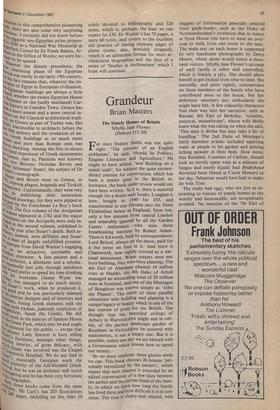Grandeur
The Stately Homes of Britain Sibylla Jane Flower (Debrett 12.50)
-Por once Sydney Smith was not quite
right. 'The pursuits of an English nobleman', he said, 'should be Politics, Elegant Literature and Agriculture.' He ought to have added, 'and Building on a manic scale', for without the quite extraor- dinary passion for construction which has been a potent gene in the British in- heritance, the book under review would not have been written. As it is, there is material enough for a dozen such books. Longleat is here, bought in 1540 for £53, and transformed in one lifetime into the finest Elizabethan house in England; Syon too, only a few minutes from central London and miserably ignored by all the Garden Centre enthusiasts who miss those breathtaking interiors by Robert Adam. There is lckworth, built by correspondence; Lord Bristol, always on the move, paid for it but never set foot in it. And there is Chatsworth, now rightly revered as a nat- ional monument. When owners were not busy building, they were busy planting. The 4th Earl of Aberdeen planted 14 million trees at Haddo, the 4th Duke of Atholl managed an astonishing total of 20 million trees in Scotland, and one of the Montagus of Boughton was known simply as 'John the Planter'. The result of these parallel obsessions with building and planting is a unique legacy of beauty which is one of the last sources of pride for the British. The thought that the beautiful ceilings of Arbury in Warwickshire might end in rub- ble, or the perfect landscape garden of Rousham in Oxfordshire be covered with maisonettes, is not a happy one. But it is possible, unless one day we are blessed with a Government which knows how to spend our money.
So we must celebrate these glories while we can. This book chooses 20 houses 'per- sonally introduced by the owners', which means that each chapter is preceded by an edited conversation of a few lines between the author and the current head of the fami- ly, in which we learn how long the family has lived there and how difficult it is to con- tinue. The tone is chatty and relaxed, with nuggets of information generally omitted from guide-books, such as the Duke of Northumberland's revelation that in winter at Syon House you have to wear an over- coat to walk from one room to the next. The main text on each house is supported by very handsome photographs by Derry Moore, which alone would entice a thou- sand visitors. Sibylla Jane Flower's account of each family is sober and controlled, which is frankly a pity. She should allow herself to get excited from time to time. She naturally, and quite rightly, concentrates on those members of the family who have contributed most to the house, but her deference smothers any enthusiasm she might have felt. A few colourful characters find their way into her narrative, such as Randal, 8th Earl of Berkeley, 'scientist, autocrat, misanthrope', whose wife Molly knew what she was taking on when she said, 'This man is divine but may take a bit of handling.' The 2nd Duke of Montagu's fairly harmless pranks included squirting water at people in his garden and putting itching powder in their beds. How ironic that Rosalind, Countess of Carlisle, should look so sternly upon wine as a mixture of fungus and smelly liquid; had Brideshead Revisited been filmed at Castle Howard in her day, Sebastian would have had to make do with Tizer.
The really bad eggs, who are just as in- teresting to visitors of stately homes as the worthy and honourable, are scrupulously avoided. No mention of the 7th Earl of Pembroke, a pathological bully who was thought to have murdered well over 20 people; nor of the 6th Duke of Marlborough and his wicked mock mar- riage ceremony with Miss Law. The stately homes should parade their rogues rather than hide them, and perhaps double the number of visitors. Miss Flower might also have included the wonderful remark made by Duchess Fanny to Consuelo Vanderbilt when the latter became Duchess of Marlborough in 1896. 'Your first duty is to have a child', she said, 'and it must be a son, because it would be intolerable to have that little upstart Winston become Duke.' Consuelo obeyed, and rescued Winston from a lifetime in the House of Lords.
Miss Flower is best on Knebworth, on which she is already an authority. But she goes seriously wrong on Chatsworth, which makes the wary reader wonder how reliable are the other chapters. She says, for exam- ple, that Duchess Georgiana did not leave her mark on Chatsworth, whereas there are ceilings, chimney-pieces and French fur- niture which she put there. She claims that Lady Elizabeth Foster fled from her hus- band, which is not true; he deserted her, and she was known, by the way, as 'Lady Liz' or 'Bess', not 'Lady Betty'. It is the fault of the editors rather than Miss Flower that the famous great marble foot in a cor- ridor at Chatsworth is described as a 19th- century fake, when they should have known that its genuine Greek provenance was at- tested over a year ago by Carlos Pidm.











































 Previous page
Previous page